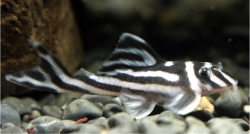

They also have two pectoral fins located close to their head and one set of large striped rayed fins. They are about 7.6-10.2 cm when mature and have a dorsal fin shaped like a triangle. Like other species of their type, they have four noticeable whiskers, which they use to explore their environment. They have a suckermouth flanked by a pair of barbels on each side, and their mouth is smaller than other Catfish species. They have an elongated body with a flat belly, and their eyes are bluish, big, and bulgy. Although pricey, the Zebra Plecos are rare and stunning fishes and are a must-have!Īlthough smaller in size than other pleco species, the Zebra Pleco has a color pattern that’s bright and uniform, which makes them unique and noticeable among other freshwater aquarium fishes. However, if you are lucky to get your hands on them, you will be able to behold their beautiful coloration and their bulbous, high-set black eyes that give them a watchful puppy aspect. They are currently classified as endangered species and can be hard to come by. However, they are found only in the Big Bend region of that river, which is currently under threat due to the construction of the Belo Monte Dam. These fish are native to the Xingu River, a tributary of the Amazon River. They are also commonly known as the Imperial pleco or L numbers, L46 or L98. As its name implies, it has the color of a zebra with black and white stripes. The L46 Zebra Pleco ( Hypancistrus zebra ) is a member of the Loricariidae family and made its first appearance in the early 1990s. Ours readily consume algae wafers as well as zucchini cut into 1/4" coins and stuck on a fork so it sinks.This guide will teach you everything you need to know to fully care for zebra pleco if you already have one or plan to get one for yourself. Even though they are carnivores, they do need some veggies in their diet to balance things out. They also enjoy rasping on large sinking pellets and wafers. They appreciate meaty frozen foods such as frozen brine shrimp and bloodworms. These fish will only eat sinking foods, which they rasp from the floor of the tank. When kept in warmer water, oxygen saturation is compromised, so water movement and clean water become especially important in order to keep enough oxygen available for these plecos.ĭiet: Peaceful Carnivore: All Hypancistrus species we are aware of are carnivores. However, we know several aquarists, including ourselves, who are keeping several thriving Hypancistrus species long term in the upper 70's F with simple sponge filters and box filters. They are reputed to like warm water from the low to mid 80's F. In our aquariums, they appreciate high flow and require clean, well oxygenated water in order to thrive. Specific Care Requirements: Hypancistrus plecos generally come from swiftly flowing waters that are clean and rich in oxygen. So, for happy plecos, provide several cave options so each individual fish can find a satisfactory home to claim as their own. If insufficient caves are provided, these plecos will continuously battle for the best homes and can do serious damage to each other. If appropriate caves are not provided, the plecos are likely to experience prolonged stress which will compromise their health. The caves should be small enough to be a somewhat snug fit. In our aquariums, providing lots of cave options for our plecos helps them feel secure. They also use these caves as spawning sites. When threatened, they squeeze in tight, expand their bodies, and spread their fins to avoid being dislodged. These fish each claim a cave and retire to it to rest and escape threats.
#Zebra pleco full#
Setup Considerations: These fish's natural environments are full of rocks with lots of crevices and caves. Overview: These guys are peaceful and stay relatively small at 4" so are a great option for most tank sizes. Estimated Size at Shipping: 1.75-2.5" give or take a bit


 0 kommentar(er)
0 kommentar(er)
